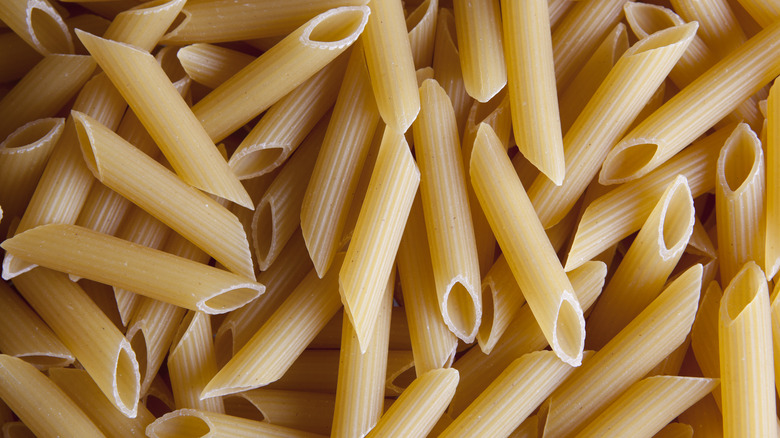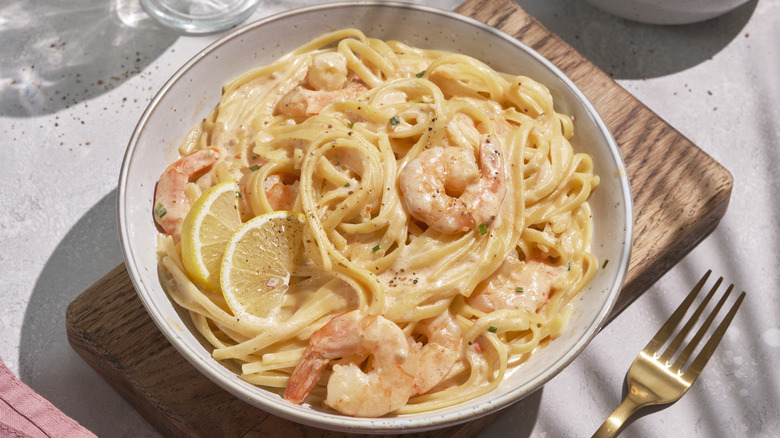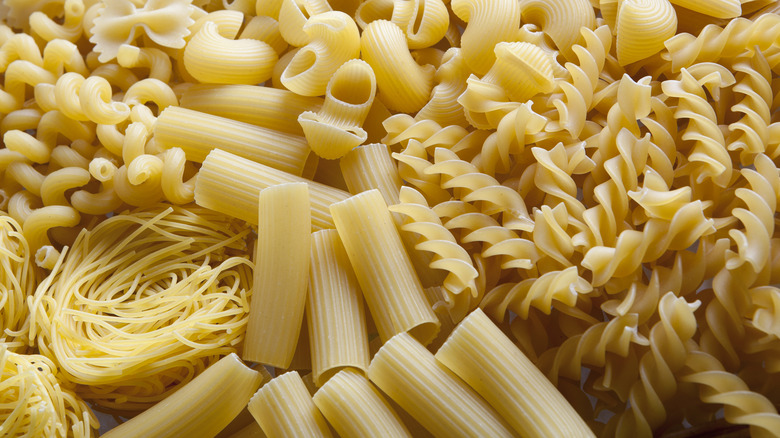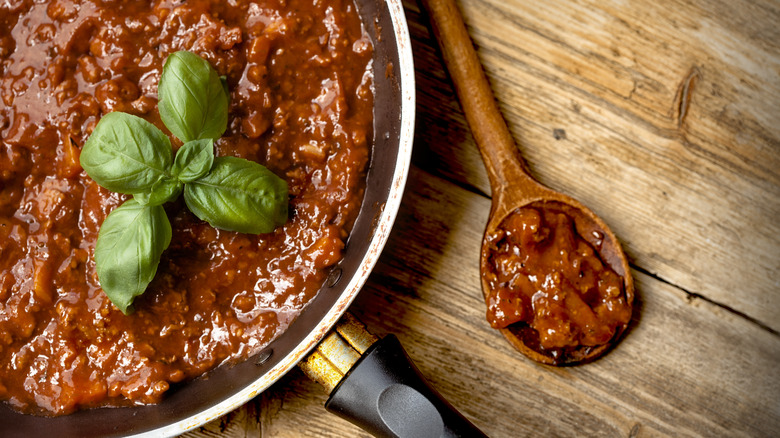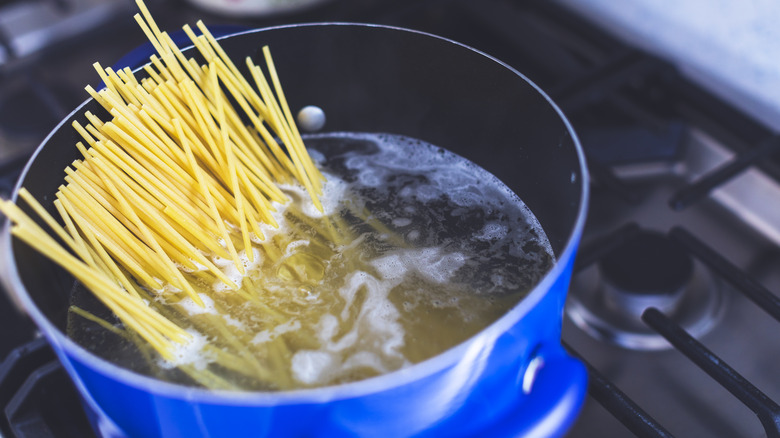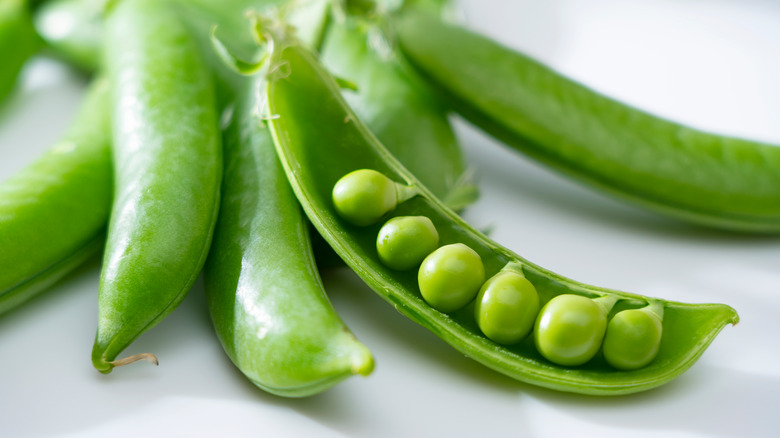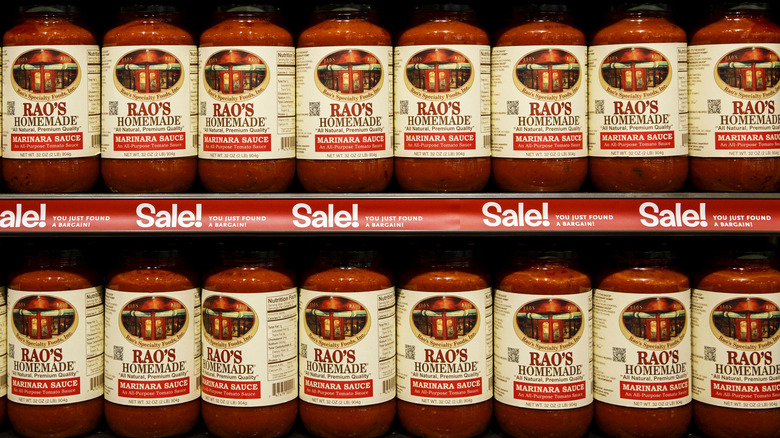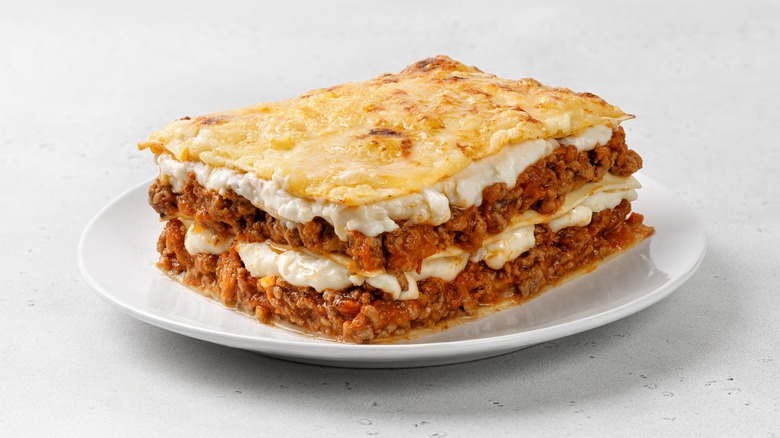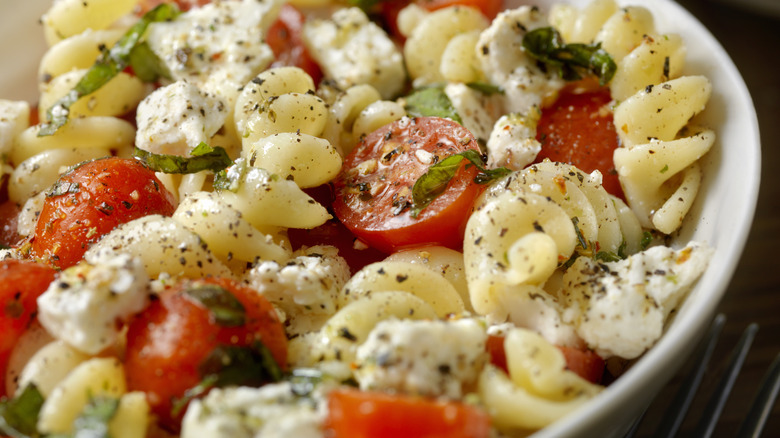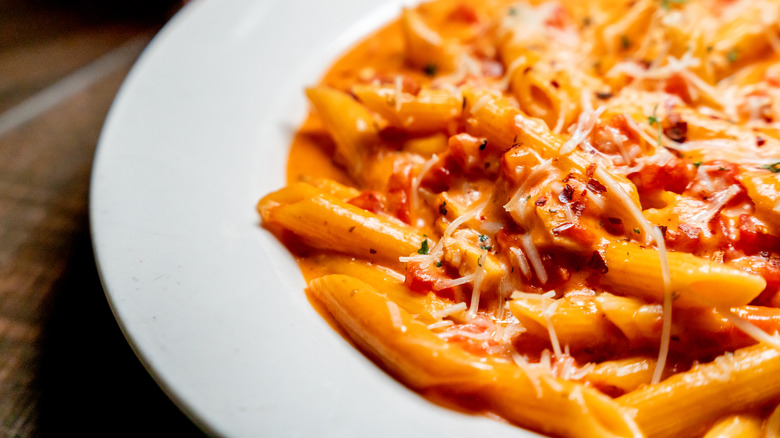12 Pasta Cooking Tips From Ina Garten That Will Change Your Life
Few celebrity chefs are as loved as Ina Garten. The Barefoot Contessa has decades of experience in cookbook writing and making easy yet delicious meals on her TV shows. Starting her food career by buying a specialty food store in the Hamptons and translating the success of her business into a television empire, Garten has built a reputation for classic recipes that take just a few good-quality ingredients but produce excellent results, often with an innovative twist of her own making to make things even tastier. How fabulous is that?
Many of Garten's most-loved recipes contain pasta, and her show has tackled many of the all-time greats, like aglio e olio, mac and cheese, and linguine with shrimp scampi. Along the way, she's offered up some top tips to ensure that you're cooking your pasta correctly and to the best quality that it can be every single time. Instead of you having to trawl through her recipes to find them, though, we thought we'd lay them out here for you. In this article, we focused on simple-to-perform tips that will ensure your pasta is perfectly cooked every time and simple tweaks to classic pasta sauces or pasta-and-sauce combos that elevate your dish.
1. Keep two good-quality boxed pastas to hand
Garten often mentions on her show that you should have a good"version of your ingredients, and this is rarely more important than when it comes to pasta. However, instead of requiring you to use fresh pasta, Garten suggests you keep two good-quality boxed pasta in your pantry. "I have basically two categories of pasta. I most often use De Cecco pasta, which I think is really good quality. I'll use any shape, like fusilli, penne, bow ties, whatever I'm in the mood for," she says in a Bon Appetit article. Garten then goes on to say that she also keeps Cipriani Food Tagliarelle on hand for more special meals, which she points out is essentially linguini.
For Garten, fresh pasta is best kept off her table, as she mentions that it's a bit too doughy a lot of the time — but the Cipriani Food Tagliarelle works as an excellent substitute. Fresh pasta also goes bad way quicker than boxed pasta, meaning that you can stock up on the good stuff in advance and not worry about spoilage. Having a variety of boxed pasta also means that she has the perfect shape on hand for the sauce she's making and that she's not limited to one style. This is especially important as certain kinds of pasta are poorly suited to certain sauces, with thinner noodles usually better for light sauces and thick noodles best for chunky ragus or bolognese.
2. Cook your pasta in the sauce to finish it
Another of Ina Garten's top tips is combining things a little earlier than you might think. While some chefs are content to spoon their pasta sauce over their cooked pasta, Garten instead likes to put her pasta into her sauce when it's still a few minutes undercooked. The reason for this, Garten states, is so that the pasta can be flavored by the sauce, giving you more bang in every bite.
When you add slightly undercooked pasta to a sauce, the noodles continue to soften and release more starch as they finish off cooking. This causes the sauce to stick to the pasta more readily instead of simply dripping off your noodles and pooling at the bottom of your plate. The starch released also serves as a thickener for your sauce, giving it more body, and if you've salted your pasta water, it will also help to season the sauce slightly. When you're doing this trick with sauces that have big pieces of food in them, like shrimp or chunks of meat, finish things off by using tongs to place the items on top of the pasta in the bowl so that they don't get lost in your noodles.
3. Mix together different pasta shapes
If there's one thing Ina Garten understands how to do, it's make cooking fun. This extends not just to her warm, welcoming demeanor but also to the choices she makes with her food. One of her best pieces of advice, to combine different pasta shapes in the same dish, exemplifies this.
Garten will typically make a pasta meal with two varying types of pasta, like her baked pasta with tomatoes and eggplant, which combines penne rigate and fusilli. This combination has two purposes. Using two different types of pasta provides a variety of textures in your dish, which makes your meal way more interesting to eat. It also means that different bites taste slightly different, depending on how much sauce your pasta has picked up, providing a flavor dynamism. As well as this, it's also a canny move to use up all of those leftover shapes of pasta that you have sitting at the bottom of bags at the back of your pantry.
You can do this with pretty much any type of pasta, but it's advisable to use pasta shapes that are roughly the same size as each other and have similar dimensions. For example, combining long, thin spaghetti with tiny pieces of orzo is unlikely to work, whereas making an arrabbiata with farfalle and radiatori will be far more cohesive and create a perfect variance of texture.
4. Cook unexpected pastas for classic sauces
We all know the classic combos: Macaroni and cheese, spaghetti and meatballs, penne arabbiatta. However, while these pairings of pasta and sauce are tried and tested, Ina Garten suggests mixing things up to take advantage of little-known pasta shapes with structural advantages. She demonstrates this with her weeknight pasta bolognese recipe. Instead of opting for the more standard tagliatelle for bolognese, Garten goes for the small, ear-shaped orecchiette.
The reason she does this is to maximize the pasta-to-sauce ratio. "The sauce just gets caught in all those little shells," Garten explains via YouTube, in contrast to what happens when you use a thin, long pasta, where the sauce just falls through to the bottom of your plate. Using a smaller, bitesize pasta also helps with the spoonable nature of the dish, with the orecchiette way closer in size to the pieces of meat and vegetables, giving better cohesion throughout. If you don't have orecchiette, using the shell-shaped conchiglie or the even smaller conchigliette also works well. If you really want something that you can spoon to your heart's content, you can also try using orzo with bolognese.
5. When making mac and cheese, leave it out overnight
Mac and cheese is the ideal dish for making ahead and cooking later. If you're Ina Garten, however, exactly how far ahead you make it might be way more than others. Garten's top tip for mac and cheese is to combine your ingredients a full 24 hours before you cook it. She simply pours her cooked pasta into the dish and combines it with heavy cream, nutmeg, her chosen cheeses, and seasonings before covering everything and leaving it to refrigerate.
The choice to do this may seem long, but it's actually a canny timesaver. By leaving her mac and cheese out overnight, she avoids the hassle of having to make a béchamel on the stove, which requires a lot of pouring, simmering, and stirring. Instead, the creamy ingredients combine as the pasta dish rests. While it does so, the cooked pasta also sucks up a lot of the heavy cream, giving it way more tenderness and making each piece larger. This is aided by the release of starch into the cream mixture by the hot pasta, which further helps to thicken things up.
6. Reserve your pasta water for a smoother sauce
Sometimes, Ina Garten's tips for cooking pasta are totally innovative — but other times, she sticks to teaching the fundamentals. Her use of reserving pasta water and pouring it into her sauces is a great example of this. When making the classic aglio e olio, Garten a pound of dried spaghetti in a large pot of salted boiling water. Once the pasta is finished cooking, she spoons out 1.5 cups of the water, just before she drains the noodles. She then adds it to the cooked garlic and oil to make a thick, luscious sauce.
Garten's reserving of pasta water falls in line with a long tradition of doing so as a means to add body and velvetiness to pasta sauces. When dried pasta cooks, it releases a huge amount of starch into the water. This starch helps to smooth out sauces and is useful both when you need to thicken a thin sauce by simmering it down with the starchy content, or thin a thick sauce quickly without ruining its flavor. Because your pasta water is salted, it helps to season your sauce, giving it extra flavor as well as improving its texture. Additionally, the starch content helps your sauce adhere to the noodles better, making your eventual dish feel way more united.
7. Make traditional pasta dishes lighter with vegetables
Many pasta dishes are light and vibrant, but when we think of dishes made from these carbs, we usually go to the creamy, heavy meals first. Thankfully, Ina Garten has found a way to marry these sturdier dishes with healthy, nutritious principles. She demonstrates this with her spring green spaghetti carbonara. The chef begins her sauce by making a carbonara in a standard way, by combining pancetta with egg yolks and cream. Into that, though, she throws an abundance of vegetables by way of snow peas, fresh peas, and asparagus, which she cooks with her pasta, alongside some scallions and chives for freshness.
Why doesn't Garten just make her carbonara the classic way? The simple reason is that it can just be way too heavy. "It's like cream and bacon and cheese, and you want to take a nap afterwards. I mean, it's delicious, but it's really rich," she explains via NPR. By adding vegetables, Garten creates a meal that's both comforting and fresh, and which contains all-important vitamins and minerals, with minimal effort. "It's just simple and it's delicious and it's got a freshness about it that classic pasta carbonara doesn't have."
8. Sometimes, store-bought sauce is fine
Ina Garten's timeless catchphrase, "store-bought is fine," has been said time and time again on her Food Network show when describing an ingredient that can be hard to make. Luckily, the cook practices what she preaches. One of her biggest tips is to fill your pantry with good quality, simple jarred sauces, like Rao's Marinara Sauce, which you can use in mere seconds. "I think you can spend the entire day making good marinara sauce, or you can buy Rao's Marinara sauce, which I think is just fantastic," says Garten, per Bon Appetit. "It's great for lasagna. It's great for pasta. It's great for putting together a really fast dinner."
Stacking up your pantry with a simple tomato sauce like this makes sense, as not only does it work as a pasta sauce on its own, but it's awesome as a base for more complicated sauces. By using Rao's Marinara Sauce in a bolognese, for instance, you eliminate the need for a lot of seasoning or dried herbs — the hard work is done for you. Garten also recommends relying on another store-bought staple, pesto, to stock your cupboards with. While she mainly uses store-bought pesto in her minestrone soup recipe, a good quality one will pair effortlessly with pasta.
9. Give lasagna a fresh twist with unique ingredients
Do you always make your lasagna the same way? Well, that's all about to change, thanks to Ina Garten's next tip. Garten recommends creating lasagnas with ingredients you wouldn't normally think of to bring freshness and lightness to your dish. Rather than fill her lasagna with ground beef, she instead chooses to use a combination of mild and spicy turkey sausage, which she breaks down in her pan with some olive oil and aromatics. Garten also mixes goat cheese with her other cheeses. "I know it's unusual in a lasagna, but I really think it gives it great flavor," she states via YouTube.
The use of goat cheese gives your lasagna an added depth, with its briny flavor helping to cut through the richness of ricotta and the milkiness of mozzarella. Choosing turkey sausage, too, stops the lasagna from tasting too dense, with the lightness of the turkey meat cutting through the density of the meal. Adding preseasoned turkey sausage also imbues the pie with an enormous amount of flavor, stopping you from having to think about how to season it yourself.
10. Marinate your fresh ingredients in olive oil
Pasta is the ideal ingredient for a summer dish, provided that it's combined with fresh, seasonal ingredients. Sometimes, though, it's just not enough to toss sliced tomatoes and basil in a bowl with cooked pasta and little else, and doing so can leave you with a flat, vegetal-tasting dish that ends up with a grainy texture. Ina Garten avoids this and creates intense flavor in the process by marinating her fresh ingredients in olive oil when she makes her summer garden pasta.
After slicing cherry tomatoes and basil leaves and crushing some garlic, she combines them with some red pepper flakes and soaks them all in olive oil for roughly four hours. She then adds cooked pasta and some grated parmesan and serves. Marinating her ingredients causes all of their flavors to amalgamate with each other and intensify, creating a summery, punchy dish that avoids being too heavy on one individual taste. Additionally, the vegetables and seasonings flavor the oil, and when this is slicked over the pasta, it gives every bite maximum flavor. The marination process also helps soften the tomatoes and the basil, removing any grittiness and removing the sharpness of the crushed garlic.
11. For pasta salad, keep your pasta warm
One of the main problems with making pasta salad is that it can turn out tasteless. When you add ingredients to cold pasta, they tend to just sit on the outside of your noodles and not incorporate them. Because the noodles in question usually have to be pretty thick to hold their shape in the salad, a lot of your meal ends up tasting of plain pasta with a hint of dressing on top of it.
Thankfully, Ina Garten can teach you how to prevent this with a simple trick: Dressing your pasta salad while it's still warm. After you've drained your pasta, place it straight into a big bowl and add your salad ingredients instantly. By doing this, you maximize the flavor of your pasta salad because the cell walls of the starch molecules in your pasta will be open, thanks to the heat and the water it's been cooked in. Therefore, any ingredients you add at this point will be absorbed into the top layers of the pasta, giving each piece more bite.
Garten also recommends going big on your pasta salad flavors. Don't be shy about using salty, briny ingredients like olives and capers, as these will offset the plainness of the pasta and give the dish more zing. Acidity from vinegar or lemon juice is also an important component.
12. Bake your sauce for penne alla vodka
Penne alla vodka is a uniquely flavorful pasta sauce, thanks to the vodka intensifying the flavors of the tomatoes and cream without any bitter alcoholic taste left over. Adding vodka, though, is not the only way that you can extract maximum flavor from this sauce, as Ina Garten shows. Rather than adding the vodka to the cooked tomatoes, as some recipes stipulate, Garten prefers to cook the vodka down with her aromatics and then add some hand-crushed tomatoes. She then clamps the lid on the pot and bakes the whole thing for roughly 90 minutes in a 375-degree Fahrenheit oven.
Baking the sauce unlocks different flavors in the tomatoes that simmering could not. The slow cooking process helps the tomatoes caramelize somewhat, and while they won't brown on the top due to the lid being on, their steady contact with the hot pan will produce newly developed tastes. The extended cooking time also gives the garlic, oregano, and red pepper flakes in the sauce more time to break down, with the garlic, in particular, becoming sweeter and more mellow-tasting. By blending her sauce, Garten ensures that every morsel of flavor is spread throughout the dish.

